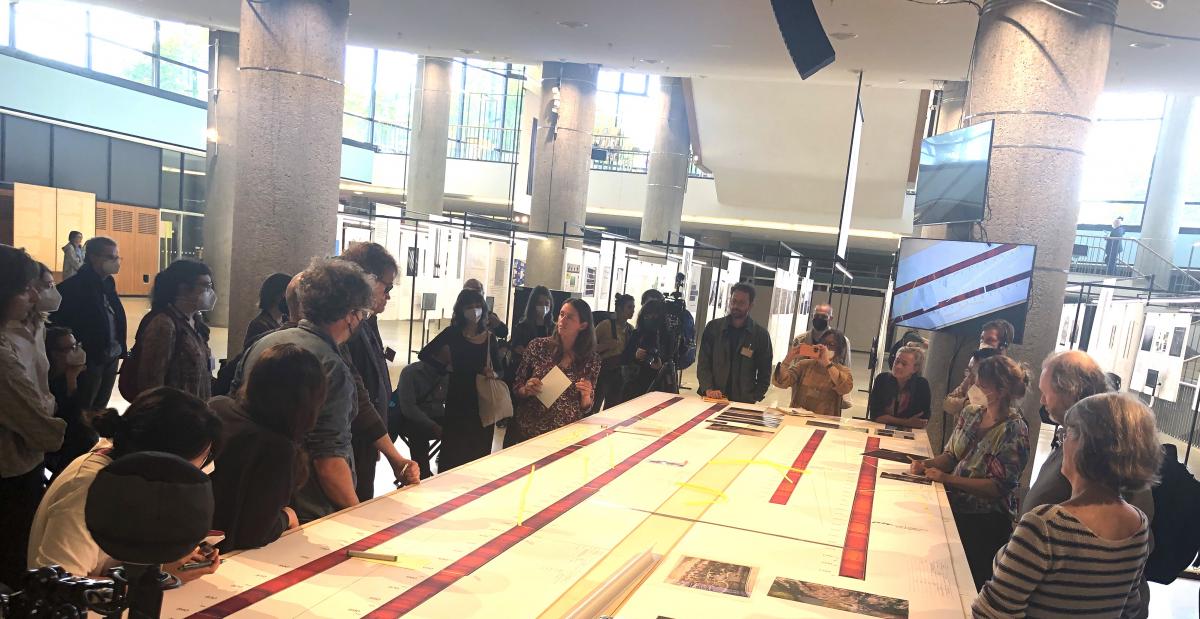Searsville Reservoir Goes International

An ongoing exhibit at the Haus der Kulturen der Welt (HKW) in Berlin, Germany features Searsville Reservoir as one of the twelve sites from around the world that are being considered as the global reference site defining a new geological epoch, the Anthropocene.
Entitled Earth Indices, the exhibit opened May 19 and will run through October 17, 2022. It resulted from collaboration between two artists, Giulia Bruno and Armin Linke, and teams of scientists who have been hard at work over the past several years to define what the Anthropocene means from both geological and societal perspectives. The exhibit documents the process scientists are using to find the site in the world that best exemplifies how the Anthropocene is expressed in geological deposits, a necessary step in formally recognizing a change in the Earth System that has been wrought by the myriad impacts of now almost 8 billion people on our planet.

Museum visitors at HKW in Berlin gather around a full-sized printout of a Searsville core to participate in an interactive reading of the story the sediments tell about the Anthropocene globally, regionally and locally. In the background is the exhibit that illustrates how scientists from around the world are collaborating to define and characterize the Anthropocene.
How to define the Anthropocene has been a topic of years-long debate by academics whose disciplinary views span the natural and social sciences as well as the arts and humanities. The debate has been whether the word “Anthropocene” should refer to the long progression of gradual changes that resulted from ever-growing human activities since Homo sapiens first became a species, or as a threshold event that essentially tipped the Earth System into a new operating state. The answer that has emerged through exhaustive study favors the latter: around the middle of 20th century, nascent geological deposits around the world began to incorporate simultaneous worldwide signals that indicate the world quit working as it did in the Holocene, and now follows a new set of rules largely created by human activities.
The Earth Indices exhibit is all about how we recognize that, and which sites in the world illustrate it best. Sediment cores from Searsville Reservoir are so important because they tell a story that is echoed in most other kinds of geological deposits that have been studied, revealing global, regional, and local signals of how the planet changed in the mid-20th century—exactly the time that the Anthropocene has been proposed to begin. Critical for recognizing this beginning are globally synchronous signposts such as the first appearance and rise of the human-made element plutonium tracking the rise and fall of nuclear weapons testing; increasing carbonaceous particulates recording the increasing burning of fossil fuels; and geochemical signals indicative of anthropogenic climate change and human-induced changes to the amount of reactive nitrogen on Earth. Also important are local and regional signals, which document increasing changes in land use through the 20th century. Such signals differ in detail from place to place, but in many places--perhaps most--accelerate in a more or less recognizable pattern. At Searsville, such changes are evident through looking at (sub)fossil pollen and aquatic microbiota such as ostracods and cladocerans.
The difference between Searsville and most other sites is the incredible detail in which the changes from the Holocene to Anthropocene are recorded in the Searsville cores. The rapid deposition rate means the record can be read year-by-year, season by season, a level of resolution highly unusual in geological deposits, in fact found elsewhere primarily only in long cores from glacial ice.
Other sites featured in the exhibit, and which also are being evaluated as candidates for the Anthropocene “golden spike” (technically called the Global Boundary Stratotype Section and Point, or GSSP), include two other lakes (one in China, one in Canada), three marine deposits (one in San Francisco Bay, one in the Baltic Sea, and a third in Japan), two coral reef sites (one in the Gulf of Mexico, another off the coast of Australia), an Antarctic ice core, a peat deposit from Poland, a speleothem (stalagmite) from a cave in Italy, and urban-archaeological sediments in Austria.
Teams from all of the sites presented their evidence at HKW in May, in conjunction with the opening of the artistic exhibit. Now each team has submitted their findings as a research paper that is being evaluated for publication in The Anthropocene Review. When all of that information is assembled, the evidence for each site will be examined by The Anthropocene Working Group (AWG), an international body of scholars involved in determining whether the “Anthropocene” indeed fits the criteria for a new geological Epoch that would herald the end to the Holocene. This fall, the AWG members will elect the site they feel is most appropriate for the Anthropocene GSSP, and make the recommendation for the formal definition of the Anthropocene, its beginning, and the GSSP to their governing body, the Subcommission on Quaternary Stratigraphy, who in turn will vote on the recommendation, then send it up the line to their governing body, the International Commission on Stratigraphy (ICS). If the ICS approves the recommendation, it then goes to the International Union of Geological Sciences for ratification. After ratification the GSSP site is published in the journal Episodes and a GSSP dedication ceremony is held at the site.
Will Searsville be the “winner?” The jury is still out, of course. But whatever the governing bodies of geology decide, there is no doubt about one thing. Humans have changed the planet we live on, and unbeknownst to the builders of Searsville Dam, they inadvertently created a rich archive that tells us just how significant our actions have been.



